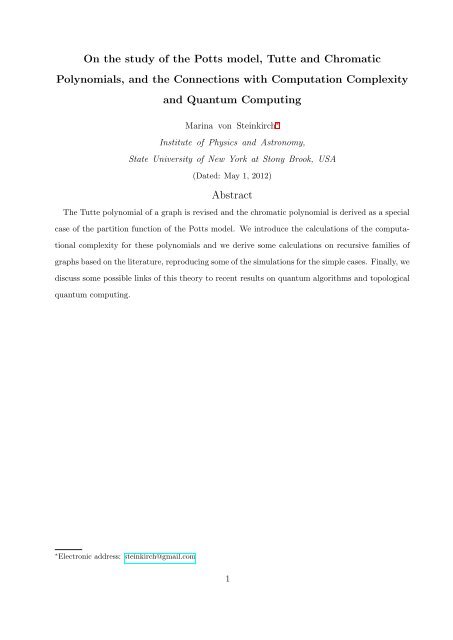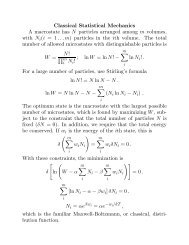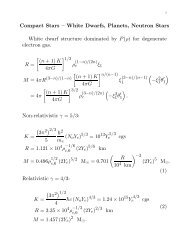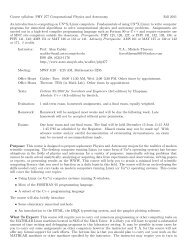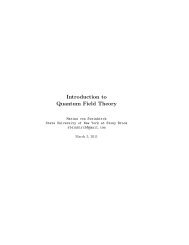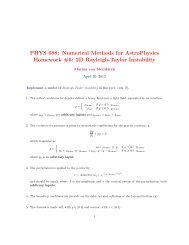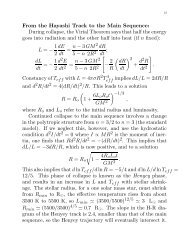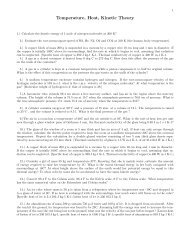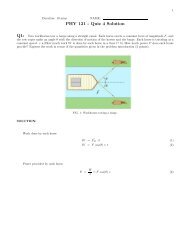On the study of the Potts model, Tutte and Chromatic Polynomials ...
On the study of the Potts model, Tutte and Chromatic Polynomials ...
On the study of the Potts model, Tutte and Chromatic Polynomials ...
Create successful ePaper yourself
Turn your PDF publications into a flip-book with our unique Google optimized e-Paper software.
<strong>On</strong> <strong>the</strong> <strong>study</strong> <strong>of</strong> <strong>the</strong> <strong>Potts</strong> <strong>model</strong>, <strong>Tutte</strong> <strong>and</strong> <strong>Chromatic</strong><br />
<strong>Polynomials</strong>, <strong>and</strong> <strong>the</strong> Connections with Computation Complexity<br />
<strong>and</strong> Quantum Computing<br />
Marina von Steinkirch ∗<br />
Institute <strong>of</strong> Physics <strong>and</strong> Astronomy,<br />
State University <strong>of</strong> New York at Stony Brook, USA<br />
(Dated: May 1, 2012)<br />
Abstract<br />
The <strong>Tutte</strong> polynomial <strong>of</strong> a graph is revised <strong>and</strong> <strong>the</strong> chromatic polynomial is derived as a special<br />
case <strong>of</strong> <strong>the</strong> partition function <strong>of</strong> <strong>the</strong> <strong>Potts</strong> <strong>model</strong>. We introduce <strong>the</strong> calculations <strong>of</strong> <strong>the</strong> computational<br />
complexity for <strong>the</strong>se polynomials <strong>and</strong> we derive some calculations on recursive families <strong>of</strong><br />
graphs based on <strong>the</strong> literature, reproducing some <strong>of</strong> <strong>the</strong> simulations for <strong>the</strong> simple cases. Finally, we<br />
discuss some possible links <strong>of</strong> this <strong>the</strong>ory to recent results on quantum algorithms <strong>and</strong> topological<br />
quantum computing.<br />
∗ Electronic address: steinkirch@gmail.com<br />
1
Contents<br />
I. Introduction to Graph Theory 3<br />
A. Graphs <strong>and</strong> Subgraphs 3<br />
B. Graph Coloring 4<br />
C. The <strong>Chromatic</strong> Polynomial 4<br />
D. Deletion-Contraction Property 6<br />
E. The <strong>Tutte</strong> Polynomial 7<br />
F. <strong>Chromatic</strong> Roots 7<br />
II. Introduction to <strong>the</strong> <strong>Potts</strong> Model 10<br />
A. A Model for Interacting Spins 10<br />
B. The <strong>Potts</strong> Model Partition Function 11<br />
C. The <strong>Potts</strong> Model Partition Function <strong>and</strong> <strong>the</strong> <strong>Tutte</strong> Polynomial 12<br />
D. The Antiferromagnetic <strong>Potts</strong> Model 14<br />
E. Exact Calculations on Recursive Graphs for <strong>the</strong> <strong>Potts</strong> Partition Function 15<br />
F. Thermodynamics Functions <strong>and</strong> Phase Transition 16<br />
III. Some Connections to Quantum Computing 18<br />
A. Partition Function Algorithm (Superpolynomial Speed) 18<br />
B. Knot Invariants Algorithms (Superpolynomial Speed) 19<br />
C. Applications on Topological Quantum Computing 20<br />
IV. Discussion 22<br />
References 24<br />
2
I. INTRODUCTION TO GRAPH THEORY<br />
A. Graphs <strong>and</strong> Subgraphs<br />
In ma<strong>the</strong>matics <strong>and</strong> physics, <strong>the</strong>re are several problems where one is interested in calculating<br />
a function on a graph,<br />
G = G(V, E),<br />
where V is <strong>the</strong> set <strong>of</strong> vertices (sites) <strong>and</strong> E is <strong>the</strong> set <strong>of</strong> edges (bonds) [1].<br />
FIG. 1: (Right) Petersen Graph is an example <strong>of</strong> a 3-regular graph, with 10 vertices, 15 edges, <strong>and</strong><br />
where each vertex has 3 neighbors. (Left) It is also an example <strong>of</strong> a non-planar graph, i.e., <strong>the</strong>re<br />
are crossing edges [2].<br />
Definition I.1 A spanning subgraph G ′ <strong>of</strong> G is G ′ = (V, E ′ ) with E ′ ⊆ E, i.e., it has <strong>the</strong><br />
same vertices <strong>and</strong> a subset <strong>of</strong> <strong>the</strong> edges <strong>of</strong> G [1].<br />
Definition I.2 A connected graph with no cycles is a tree.<br />
Definition I.3 A spanning subgraph G ′ with no cycles is a spanning forest <strong>of</strong> G.<br />
Definition I.4 The complete graph K n is <strong>the</strong>( graph with n vertices such that each pair <strong>of</strong><br />
n<br />
vertices is connected by an edge, so E(K n ) = .<br />
2)<br />
Definition I.5 A loop is an edge that connects a vertex to itself. P (G, q) vanishes if G<br />
contains one or more loops.<br />
Definition I.6 A recursive family <strong>of</strong> graphs G m is a family for which <strong>the</strong> (m+1)’th member<br />
is obtained from <strong>the</strong> m’th member graph ei<strong>the</strong>r by gluing on some fixed subgraph or by<br />
cutting through <strong>the</strong> m’th member, inserting <strong>the</strong> subgraph <strong>and</strong> gluing <strong>the</strong> graph toge<strong>the</strong>r.<br />
3
B. Graph Coloring<br />
Graphic coloring, i.e., vertex coloring, is <strong>the</strong> assignment <strong>of</strong> colors to <strong>the</strong> vertex <strong>of</strong> a graph<br />
in a such way that no two adjacent vertices share <strong>the</strong> same color.<br />
Definition I.7 A q-coloring <strong>of</strong> a graph G is a function<br />
σ : V (G) → {1, 2, ..., q}<br />
satisfying σ(i) ≠ σ(j) for any edge E = i, j. The graph is said to be q-colorable if such a<br />
function exists.<br />
For instance, a graph is 2-colorable (bipartite) if it contains no odd cycle. The q-<br />
colorability for any q larger than 3 is NP-complete (e.g., <strong>the</strong> question Does G have a<br />
proper 3-coloring) <strong>and</strong> finding <strong>the</strong> chromatic number is P-complete , i.e., it is unfeasible<br />
to calculate it in an efficient way [35].<br />
C. The <strong>Chromatic</strong> Polynomial<br />
George Birkh<strong>of</strong>f introduced <strong>the</strong> chromatic polynomial in 1912 as an attempt to prove <strong>the</strong><br />
four color <strong>the</strong>orem [3]. He noticed <strong>the</strong> number <strong>of</strong> ways he could paint a map with at most q<br />
colors exhibits polynomial dependence on q yielding some conclusions on q−colorability (he<br />
hoped to be able to find an analytic pro<strong>of</strong> that P G (4) > 0 for any planar graph G).<br />
Definition I.8 The chromatic polynomial P (G, q) is <strong>the</strong> number <strong>of</strong> ways <strong>of</strong> assigning q<br />
colors to <strong>the</strong> vertices <strong>of</strong> G such that no two adjacent vertices have <strong>the</strong> same color.<br />
Definition I.9 The chromatic number χ(G) is <strong>the</strong> minimal q for which <strong>the</strong> graph is q-<br />
colorable (i.e., <strong>the</strong> minimum number <strong>of</strong> colors needed for a proper coloring <strong>of</strong> G) <strong>and</strong> G is<br />
q-chromatic if χ(G) = q,<br />
χ(G) = min{P (G, q) > 0}.<br />
For example, <strong>the</strong> path graph P 3 on 3 vertices cannot be colored with 0 or 1 colors. With 2<br />
colors, it can be colored in 2 ways. With 3 colors, it can be colored in 12 ways [5]. Ano<strong>the</strong>r<br />
example is <strong>the</strong> tree graph, where <strong>the</strong>re are q choices <strong>of</strong> colors for an arbitrary first vertex<br />
<strong>and</strong> <strong>the</strong>n q − 1 choices for each subsequent vertex (see Fig. 3).<br />
4
FIG. 2:<br />
In 1852, Guthrie noticed that he never needed more than 4 colors on any map (planar<br />
graph). The four color <strong>the</strong>orem was an open problem for almost a century until it was proven in<br />
1976 by Appel <strong>and</strong> Haken [2].<br />
FIG. 3: Coloring a tree graph: for any tree T on n vertices, one has P T (q) = q(q − 1) n−1 [4].<br />
Definition I.10 Two non-isomorphic graphs may share <strong>the</strong> same chromatic polynomial. A<br />
graph that is determined by its chromatic polynomial is said to be a chromatically unique<br />
graph. Non-isomorphic graphs sharing <strong>the</strong> same chromatic polynomial are said to be chromatically<br />
equivalent.<br />
Examples <strong>of</strong> classes <strong>of</strong> graphs <strong>and</strong> <strong>the</strong>ir chromatic polynomials are<br />
• Complete graph can be obtained from <strong>the</strong> definition I.4, where we can write P (K n , q) =<br />
q(q − 1)...(q − n + 1) = ∏ n−1<br />
j=0 (q − j). For example, <strong>the</strong> triangle K 3, P (K 3 , q) =<br />
q(q − 1)(q − 2) <strong>and</strong> <strong>the</strong> chromatic number is χ(K n ) = n.<br />
• Tree with n vertices, P (T n , q) = q(q − 1) n−1 .<br />
5
• Cycle <strong>of</strong> length n, P (C n , q) = (q − 1) n + (−1) n (q − 1).<br />
FIG. 4: All vertex colorings <strong>of</strong> vertex graphs with 3 vertices using q colors for q = 0, 1, 2, 3 [5].<br />
D. Deletion-Contraction Property<br />
A fundamental property <strong>of</strong> <strong>the</strong> chromatic polynomial is that it can be reduced to two<br />
smaller graphs, resulting from deletion <strong>and</strong> contraction <strong>of</strong> an edge E respectively, giving an<br />
algorithm to recursively calculate <strong>the</strong> chromatic polynomial for any graph.<br />
Definition I.11 Let G−E be <strong>the</strong> graph G with <strong>the</strong> edge E deleted <strong>and</strong> G/E <strong>the</strong> graph with<br />
E deleted <strong>and</strong> two vertices connected. The chromatic polynomial satisfies <strong>the</strong> recurrence<br />
relation,<br />
P (G, q) = P (G − uv, q) − P (G, uv, q), (1)<br />
where u <strong>and</strong> v are adjacent vertices <strong>and</strong> G − uv is <strong>the</strong> graph with <strong>the</strong> edge uv removed.<br />
An example <strong>of</strong> recurrence relations for chromatic polynomials for simple classes <strong>of</strong> graphs<br />
is for <strong>the</strong> cycle graph,<br />
P n (C n , q) = (1 − 2)P n−1 (q) + (q − 1)P n−2 (q).<br />
6
FIG. 5: The deletion <strong>and</strong> contraction <strong>of</strong> an edge [6]. A bridge is an edge whose deletion separates<br />
<strong>the</strong> graph. A loop is an edge with both incident to <strong>the</strong> same vertex.<br />
E. The <strong>Tutte</strong> Polynomial<br />
<strong>Tutte</strong> defined his two-variable dichromatic polynomial as a generalization <strong>of</strong> <strong>the</strong> chromatic<br />
polynomial <strong>and</strong> <strong>the</strong> deletion-contraction argument.<br />
Definition I.12 The <strong>Tutte</strong>-Whitney polynomial <strong>of</strong> a graph G <strong>and</strong> a spanning subgraph G ′<br />
is<br />
T (G, x, y) = ∑ − 1)<br />
G ⊆G(x k(G′ )−k(G) (y − 1) c(G′) , (2)<br />
′<br />
where c(G ′ ) is <strong>the</strong> number <strong>of</strong> linearly independent cycles in G ′ <strong>and</strong><br />
c(G) = E(G) + k(G) − n(G). (3)<br />
Special cases <strong>of</strong> <strong>the</strong> <strong>Tutte</strong> polynomial yield <strong>the</strong> chromatic polynomial,<br />
P (G, q) = (−q) k(G) (−1) n(G) T (G, x = 1 − q, y = 0).<br />
For a connected graph with vertices, <strong>the</strong> chromatic polynomial is related to <strong>the</strong> rank<br />
polynomial <strong>and</strong> <strong>Tutte</strong> polynomial by<br />
π(x) = (−1) n−1 xT (1 − x, 0).<br />
F. <strong>Chromatic</strong> Roots<br />
A root (or zero) <strong>of</strong> a chromatic polynomial is a value where P G (x) = 0. <strong>Chromatic</strong> roots<br />
have been very well studied, e.g., recall that Birkh<strong>of</strong>fs original motivation for defining <strong>the</strong><br />
7
chromatic polynomial was to show that for planar graphs, P G (x) > 0, for x > 3. If G is<br />
an n-vertex graph <strong>the</strong>n P G (z) has degree n <strong>and</strong> so this equation has n solutions over <strong>the</strong><br />
complex numbers. Fundamental questions are related to <strong>the</strong> search for absolute bounds on<br />
<strong>the</strong> root-location <strong>and</strong> <strong>the</strong> search <strong>of</strong> this bounds in terms <strong>of</strong> graph parameters [2].<br />
No graph can be 0-colored, so 0 is always a chromatic root. <strong>On</strong>ly edgeless graphs can be<br />
1-colored, so 1 is a chromatic root for every graph with at least an edge. <strong>On</strong> <strong>the</strong> o<strong>the</strong>r h<strong>and</strong>,<br />
except for <strong>the</strong>se two points, no graph can have a chromatic root at a real number smaller<br />
than or equal to 32/27. This comes from a result <strong>of</strong> <strong>Tutte</strong>, connecting <strong>the</strong> golden ratio with<br />
<strong>the</strong> <strong>study</strong> <strong>of</strong> chromatic roots. He showed that if G is a planar triangulation <strong>of</strong> a sphere <strong>the</strong>n<br />
P (G n , φ) ≤ φ 5−n .<br />
Later, Farell observed that some zeros are more “popular” than o<strong>the</strong>rs, specifically <strong>the</strong><br />
sequence {3/2 ± i √ 3/2, 2 ± i, 5/2 ± i √ 3/2, ...} [2].<br />
For many years, it was thought that chromatic zeros were restricted to <strong>the</strong> right halfplane<br />
Re(z) > 0. In 1999, Alan Sokal proved that chromatic zeros are dense in <strong>the</strong> whole<br />
complex plane [10] [36].<br />
While <strong>the</strong> real line thus has large parts that contain no chromatic roots for any graph,<br />
every point in <strong>the</strong> complex plane is arbitrarily close to a chromatic root in <strong>the</strong> sense that<br />
<strong>the</strong>re exists an infinite family <strong>of</strong> graphs whose chromatic roots are dense in <strong>the</strong> complex<br />
plane.<br />
In <strong>the</strong> case <strong>of</strong> complex zeros, generalized <strong>the</strong>ta graphs are graphs with two end points<br />
connected via paths <strong>of</strong> varying lengths. Sokal also analytically proved that all <strong>the</strong> chromatic<br />
roots <strong>of</strong> <strong>the</strong>se graphs lie within a certain disc [10].<br />
Recently, progress has been made in <strong>the</strong> <strong>the</strong>ory <strong>of</strong> zeros <strong>of</strong> recursive families (recall from<br />
Definition I.6 that a sequence <strong>of</strong> graphs {G 1 , ..., G m } is a recursive family if P (G m , m) =<br />
f(P (G m−1 ), ..., P (G 1 )), where f is some simple linear function). <strong>Chromatic</strong> zeros <strong>of</strong> recursive<br />
families <strong>of</strong> graphs obey a limiting process <strong>and</strong> Shrock <strong>and</strong> Tsai [11] proved that a certain<br />
family <strong>of</strong> graphs have zeros lying on circles <strong>and</strong> relate <strong>the</strong> results to a certain <strong>Potts</strong> <strong>model</strong><br />
(described in <strong>the</strong> next session). This paper provides an interesting link between chromatic<br />
zeros <strong>and</strong> <strong>the</strong> <strong>Potts</strong> <strong>model</strong> on a certain class <strong>of</strong> graphs.<br />
8
G. Algorithm to <strong>Chromatic</strong> Roots<br />
Computational problems associated with <strong>the</strong> chromatic polynomial are related to finding<br />
<strong>the</strong> chromatic polynomial <strong>of</strong> a given graph P G , e.g., finding its coefficients evaluating P G (q)<br />
at a fixed point q. When q is a natural number, this problem is viewed as computing <strong>the</strong><br />
number <strong>of</strong> q-colorings <strong>of</strong> a given graph. The time required for this classical calculation grows<br />
exponentially with <strong>the</strong> number <strong>of</strong> vertices, n = |V |, i.e., O(2 n ). Quantum computing may<br />
be able to reduce <strong>the</strong> calculations time to polynomial time [13].<br />
The chromatic polynomial <strong>of</strong> a general graph can also be calculated with <strong>the</strong> deletioncontraction<br />
recursion. In <strong>the</strong> worst case running time <strong>the</strong> algorithm runs in time within a<br />
polynomial factor <strong>of</strong><br />
( √<br />
1 + 5<br />
) n+m<br />
O(φ n+m ) = O<br />
= O(1.6180) n+m ,<br />
2<br />
where φ is <strong>the</strong> golden ratio <strong>and</strong> n <strong>and</strong> m are <strong>the</strong> number <strong>of</strong> nodes <strong>and</strong> edges respectively.<br />
This algorithm also has an exponential complexity <strong>and</strong> is only practical for small graphs<br />
[37]. The analysis can be improved to a polynomial time in some cases, with some spanning<br />
trees as <strong>the</strong> <strong>the</strong> input graphs [12].<br />
Ano<strong>the</strong>r calculation methods include high <strong>and</strong> low temperature series expansions, which<br />
enable one to calculate <strong>the</strong>se quantities exactly for arbitrary large n for certain families <strong>of</strong><br />
graphs [1].<br />
9
II.<br />
INTRODUCTION TO THE POTTS MODEL<br />
A. A Model for Interacting Spins<br />
In Physics, ferromagnets can be thought <strong>of</strong> as a set <strong>of</strong> interacting spins on a crystalline<br />
lattice. In <strong>the</strong> <strong>Potts</strong> <strong>model</strong>, each spin can assume one <strong>of</strong> <strong>the</strong> q possible states. If two<br />
neighboring spins (joined by an edge E) are in <strong>the</strong> same state, it adds some value J to <strong>the</strong><br />
energy given by <strong>the</strong> Hamiltonian, H, <strong>of</strong> <strong>the</strong> system.<br />
FIG. 6: (Left) The q-state <strong>Potts</strong> <strong>model</strong>, with q = 2, 3, 4 states <strong>and</strong> <strong>the</strong> coloring <strong>of</strong> <strong>the</strong> points with<br />
q colors. (Right) The q = 2-state <strong>Potts</strong> <strong>model</strong> is known as <strong>the</strong> Ising Model. A sheet <strong>of</strong> metal<br />
at low temperature is magnetized <strong>and</strong> when <strong>the</strong> temperature increases <strong>the</strong> magnetism decreases.<br />
To <strong>model</strong> this behavior one assumes that (i) individual atoms have a spin (e.g., up <strong>and</strong> down),<br />
(ii) neighboring atoms with different spins have an interaction energy (assumed constant), (iii) <strong>the</strong><br />
atoms are arranged in a regular lattice. [6]<br />
Definition II.1 The Boltzmann weight <strong>of</strong> a configuration (assignments <strong>of</strong> states to spin) is<br />
e −βH , where <strong>the</strong> probability <strong>of</strong> <strong>the</strong> configuration is proportional to its Boltzmann weight.<br />
To form a probability distribution, one normalizes with <strong>the</strong> sum <strong>of</strong> <strong>the</strong> Boltzmann weights<br />
<strong>of</strong> all configurations, i.e., <strong>the</strong> partition functions <strong>of</strong> <strong>the</strong> <strong>Potts</strong> <strong>model</strong>, which is a polynomial<br />
in terms <strong>of</strong> q.<br />
The behavior <strong>of</strong> <strong>the</strong> coupling J is determined by <strong>the</strong> willingness <strong>of</strong> spins to become aligned,<br />
being ferromagnetic if J > 0 <strong>and</strong> antiferromagnet if J < 0. The interaction is streng<strong>the</strong>ned<br />
by decreasing <strong>the</strong> temperature to <strong>the</strong> limit T = 0, where only configurations with no<br />
10
adjacent spins sharing common state will have nonzero energy. The connection to<br />
<strong>the</strong> chromatic polynomial is natural in this sense. Moreover, phase transitions are closely<br />
related to <strong>the</strong> roots <strong>of</strong> this partition function, <strong>and</strong> <strong>the</strong>refore to <strong>the</strong> roots <strong>of</strong> <strong>the</strong> chromatic<br />
polynomial.<br />
B. The <strong>Potts</strong> Model Partition Function<br />
Definition II.2 Let G be a graph <strong>and</strong> S <strong>the</strong> set <strong>of</strong> q elements called spins. A state <strong>of</strong> a<br />
graph G is an assignment <strong>of</strong> a single spin to each vertex <strong>of</strong> <strong>the</strong> graph, where <strong>the</strong> Hamiltonian<br />
measures <strong>the</strong> energy <strong>of</strong> this state.<br />
Definition II.3 The <strong>Potts</strong> <strong>model</strong> on a graph G at temperature T (β = 1/k B T ) is related<br />
to classical spin variables σ i on each vertex i in V that can take values in {1, 2, ...q}, with<br />
an interaction Hamiltonian,<br />
H = −J ∑ δ σi σ j<br />
,<br />
E ij<br />
<strong>and</strong><br />
− βH = K ∑ E ij<br />
δ σi σ j<br />
. (4)<br />
Definition II.4 The <strong>Potts</strong> <strong>model</strong> partition function is,<br />
Z = ∑ {σ i }<br />
e −βH = ∑ {σ i }<br />
e K P E ij<br />
δ σi σ j<br />
. (5)<br />
Writing ν = e K − 1 such that<br />
e Kδσ i σ j<br />
= 1 + (e K − 1)δ σi σ j<br />
,<br />
= 1 + νδ σi σ j<br />
, (6)<br />
one has<br />
Z(G, q, ν) = ∑ ∏<br />
(1 + νδ σi σ j<br />
),<br />
{σ i } E ij<br />
= ∑ q k(G′) v E(G′) , (7)<br />
G ′ ⊆G<br />
where k <strong>and</strong> E are <strong>the</strong> number <strong>of</strong> connected components <strong>and</strong> edges in G ′ . This is <strong>the</strong><br />
Fortuin-Kasteleyn cluster representation <strong>and</strong> it shows that Z(G, q, ν) is a polynomial in q<br />
<strong>and</strong> ν, since <strong>the</strong>re is a 1 − 1 correspondence between Z <strong>and</strong> <strong>the</strong> spanning subgraph G ′ .<br />
11
Example II.1: The Cyclic Group C n<br />
Let us see <strong>the</strong> case <strong>of</strong> <strong>the</strong> cyclic group, taking C 3 as an example [1],<br />
Z(C 3 , q, ν) = ∑ ∏<br />
(1 + νδ σi σ j<br />
),<br />
{σ i } E ij<br />
= ∑ (1 + νσ σ1 σ 2<br />
)(1 + νσ σ2 σ 3<br />
)(1 + νσ σ3 σ 1<br />
)<br />
σ i<br />
= 1 + ν(δ σ1 σ 2<br />
+ δ σ2 σ 3<br />
+ δ σ3 σ 1<br />
) + ν 2 (δ σ1 σ 2<br />
δ σ2 σ 3<br />
+ δ σ2 σ 3<br />
δ σ3 σ 1<br />
+ δ σ3 σ 1<br />
δ σ1 σ 2<br />
)<br />
+ ν 3 (δ σ1 σ 2<br />
δ σ2 σ 3<br />
δ σ3 σ 1<br />
),<br />
= q 3 + 3q 2 ν + 3qν 2 + qν 3 ,<br />
= (q + ν) 3 + (q − 1)ν 3 . (8)<br />
The generalization proceeds naturally,<br />
Z(C n , q, ν) = (q + ν) n + (q − 1)ν n<br />
C. The <strong>Potts</strong> Model Partition Function <strong>and</strong> <strong>the</strong> <strong>Tutte</strong> Polynomial<br />
If we generalize <strong>the</strong> regular lattice to an abstract, <strong>the</strong> q-state <strong>Potts</strong> <strong>model</strong> partition<br />
function is an evaluation <strong>of</strong> <strong>the</strong> <strong>Tutte</strong> Polynomial, <strong>and</strong> <strong>the</strong> <strong>Potts</strong> is equivalent to <strong>the</strong> <strong>Tutte</strong><br />
polynomial if both q <strong>and</strong> <strong>the</strong> temperature are viewed as indeterminate variables [7]. Let<br />
x = 1 + q ν ,<br />
<strong>and</strong><br />
so<br />
<strong>and</strong><br />
y = ν + 1 = e K ,<br />
q = (x − 1)(y − 1),<br />
ν = y − 1.<br />
We use n(G ′ ) = n(G) <strong>and</strong> similar relation given in Eq. 3,<br />
c(G ′ ) = E(G ′ ) + k(G ′ ) − n(G),<br />
12
to write <strong>the</strong> <strong>Tutte</strong> polynomial <strong>of</strong> a graph G, from Eq. 2,<br />
T (G, x, y) = (x − 1) −k(G) ∑ G ⊆G(x − 1) k(G′) (y − 1) c(G′) ,<br />
= (x − q) −k(G) ∑ G ′ ⊆G<br />
( q<br />
ν<br />
) k(G ′ )<br />
ν<br />
E(G ′ )+k(G ′ )−n(G) ,<br />
= (x − 1) −k(G) (y − 1) −n(G) ∑ G ′ ⊆G<br />
q k(G′) ν E(G′) ,<br />
= (x − 1) −k(G) (y − 1) −n(G) Z(G, q, ν). (9)<br />
This equivalence connects statistical mechanics <strong>and</strong> ma<strong>the</strong>matical graph <strong>the</strong>ory [1].<br />
Definition II.5 The <strong>Potts</strong> parameters ν <strong>and</strong> q are physical parameters when [18]:<br />
• q is an integer larger than 0, <strong>and</strong> for all edges ν E > 1; or<br />
• q > 0 <strong>and</strong> for all edges ν E > 0.<br />
Example II.2: Partition function <strong>and</strong> <strong>Tutte</strong> Polynomial for a Tree Graph with<br />
n vertices.<br />
From Eq. 7, we can write for T n ,<br />
Z(T n , q, ν) = q(q + ν) n−1 ,<br />
=<br />
( q<br />
ν<br />
) k(G)ν n T (G, x, y),<br />
= qν n−1 T (G, x, y),<br />
= qν n−1 [1 + (q/ν)] n−1,<br />
= qν n−1 x x−1 ,<br />
<strong>and</strong><br />
T (T n , x, y) = x n−1 ,<br />
where from <strong>the</strong> Definition I.10, we observe that two different graphs can have <strong>the</strong> same<br />
<strong>Tutte</strong> polynomial <strong>and</strong> <strong>Potts</strong> partition function. Setting ν = −1, gives back <strong>the</strong> chromatic<br />
polynomial,<br />
P (T n , q) = q(q − 1) n−1 .<br />
13
Example II.3: Partition function <strong>and</strong> <strong>Tutte</strong> Polynomial for a Cycle Graph<br />
with n vertices.<br />
Following <strong>the</strong> same steps as <strong>the</strong> previous example, now for C n , with x − 1 = q/ν <strong>and</strong><br />
q = (x − 1)(y − 1), one has<br />
Z(C n , q, ν) = (q + ν) n + (q − 1)ν n ,<br />
[(<br />
= ν n 1 + q ) n ]<br />
+ (q − 1) ,<br />
ν ]<br />
= ν<br />
[x n n + q − 1 ,<br />
[ x<br />
= qν n−1 n + q − 1<br />
]<br />
,<br />
x − 1<br />
<strong>and</strong> using <strong>the</strong> expansion<br />
<strong>the</strong> <strong>Tutte</strong> polynomial is<br />
∑n−1<br />
x j = xn − x<br />
x − 1<br />
j=1<br />
[ x n + xy − y − x<br />
]<br />
T (C n , x, y) =<br />
,<br />
x − 1<br />
∑n−1<br />
= y + x j ,<br />
j=1<br />
<strong>and</strong> we can recover its chromatic polynomial setting again ν = −1.<br />
D. The Antiferromagnetic <strong>Potts</strong> Model<br />
Special cases <strong>of</strong> <strong>the</strong> <strong>Tutte</strong> polynomial yield some graph-<strong>the</strong>oretic functions <strong>of</strong> interest in<br />
Physics, such as when ν = −1 (y = 0) <strong>and</strong> one recovers <strong>the</strong> chromatic polynomial <strong>of</strong> <strong>the</strong><br />
antiferromagnet <strong>Potts</strong> <strong>model</strong> (see Fig. 7).<br />
For this case, one considers <strong>the</strong> limit T → 0 <strong>and</strong> K → −∞ (with K = βJ <strong>and</strong> J < 0) <strong>and</strong><br />
ν = e K −1 → −1. The only spin configuration that contributes is <strong>the</strong> one having an adjacent<br />
spin with different value. This results on <strong>the</strong> T = 0 limit <strong>of</strong> <strong>the</strong> <strong>Potts</strong> antiferromagnetic<br />
partition function given by <strong>the</strong> following chromatic polynomial<br />
Z(G, q, −1) = P (G, q) = (−1) k(G) (−1) n(G) T (G, 1 − q, 0).<br />
14
FIG. 7: The q-state <strong>Potts</strong> <strong>model</strong> <strong>model</strong>s a physical system as collection <strong>of</strong> interacting spins, each<br />
taking on one <strong>of</strong> q distinct values, <strong>and</strong> in this case, located on a regular lattice grid. Every edge<br />
E contributes with 1 + ν if it joins equal spins. If one writes ν = −1 for every edge, one gets <strong>the</strong><br />
zero temperature limit <strong>of</strong> <strong>the</strong> antiferromagnetic <strong>Potts</strong> <strong>model</strong>, Z G (q, −1) = P G (q). (Left) The lattice<br />
may be periodic. (Right) The q = 2 case is known as <strong>the</strong> Ising Model [5]<br />
E. Exact Calculations on Recursive Graphs for <strong>the</strong> <strong>Potts</strong> Partition Function<br />
In <strong>the</strong> end <strong>of</strong> <strong>the</strong> last session we have learned that we can use <strong>the</strong> deletion-contraction<br />
recursion to calculate family <strong>of</strong> graphs. It is possible to use <strong>the</strong> same logic to rewrite <strong>the</strong><br />
Eq. 1 for <strong>the</strong> <strong>Potts</strong> partition function from Eq. 5,<br />
Z(G, q, ν) = Z(G − E, qν) + νZ(G/E, q, ν),<br />
with two possibilities for <strong>the</strong> two spins on <strong>the</strong> vertices joined by <strong>the</strong> edge E: (i) ei<strong>the</strong>r <strong>the</strong>y<br />
are different, so Z is <strong>the</strong> same as if <strong>the</strong> edge was moved, (ii) or <strong>the</strong>y are <strong>the</strong> same so it is<br />
summed by <strong>the</strong> term νδ σi σ j<br />
, (see Fig. 8).<br />
The general calculation <strong>of</strong> Z(G, q, v) for an arbitrary graph G <strong>and</strong> arbitrary values <strong>of</strong> q<br />
<strong>and</strong> ν, which is <strong>the</strong> calculation <strong>of</strong> T (G, x, y) for an arbitrary graph G <strong>and</strong> values <strong>of</strong> x <strong>and</strong><br />
y, takes a time ∝ O(e n(G) ) or ∝ O(e e(G) ). Although Z(G, q, ν) satisfies <strong>the</strong> above deletioncontraction<br />
relation, this again does not reduce <strong>the</strong> complexity <strong>of</strong> <strong>the</strong> calculation, but for<br />
some graphs, this enables to calculate exactly in <strong>the</strong> closed form, avoiding exponential growth<br />
<strong>of</strong> <strong>the</strong> time required [1].<br />
15
FIG. 8: Calculation <strong>of</strong> <strong>the</strong> <strong>Tutte</strong> polynomial for C 4 using <strong>the</strong> deletion-contraction propriety [7].<br />
First we start with G = C 4 <strong>and</strong> Z(C 4 , q, ν) = (q + ν) 4 + (q − 1)ν 4 . Subtracting any edge gives<br />
C 4 − E = T 4 , where T (T 4 , x, y) = x 3 , <strong>and</strong> Z(T 4 , q, ν) = q(q + 3) 3 .<br />
Contracting on E gives<br />
C 4 /E = C 3 , where T (C 3 , x, y) = x + x 2 + y , <strong>and</strong> Z(C 3 , q, ν) = (q + ν) 3 + (q − 1)ν 3 . Summing<br />
<strong>the</strong>se two results returns <strong>the</strong> <strong>the</strong> <strong>Tutte</strong> polynomial <strong>of</strong> C 4 , i.e., T (C 4 , x, y) = x + x 2 + x 3 + y.<br />
F. Thermodynamics Functions <strong>and</strong> Phase Transition<br />
The <strong>the</strong>rmodynamic functions, e.g., internal energy, specific heat, entropy, free energy,<br />
can be derived from <strong>the</strong> <strong>Potts</strong> <strong>model</strong> partition function, Z(G, q, ν) [8].<br />
A phase transition in a physical system occurs when continuous variation in a control<br />
parameter yields a discontinuity in its observed behavior. Statistical physicists are interested<br />
in complex zeros because a phase transition can only occur at a real limit point <strong>of</strong> <strong>the</strong><br />
complex zeros <strong>of</strong> <strong>the</strong> partition function.<br />
Hence a zero-free region for a family <strong>of</strong> graphs<br />
provides evidence that phase-transitions cannot occur in that region <strong>of</strong> parameter space<br />
- such <strong>the</strong>orems are called Lee-Yang <strong>the</strong>orems [5]. Phase transitions correspond to <strong>the</strong><br />
accumulation points <strong>of</strong> roots <strong>of</strong> <strong>the</strong> chromatic polynomial in <strong>the</strong> infinite volume limit.<br />
We consider connected graphs G without loops or multiple bonds <strong>and</strong> denote <strong>the</strong> number<br />
<strong>of</strong> vertices as n = V (G), <strong>the</strong> edges as E(G), <strong>and</strong> <strong>the</strong> chromatic number as χ(G). Based on<br />
many results from <strong>the</strong> literature, we consider <strong>the</strong> infinite length <strong>of</strong> a strip graph, denoted<br />
as {G} = lim n→∞ G [12] [31] [32] [33]. For arbitrary strip length L x = m, we consider <strong>the</strong><br />
limit n → ∞ obtained by taking <strong>the</strong> length L x → ∞. For a given type <strong>of</strong> strip graph, we<br />
can denote this as G <strong>and</strong> define a reduced free energy (per site) <strong>of</strong> <strong>the</strong> <strong>Potts</strong> <strong>model</strong>,<br />
1<br />
f(G, q, ν) = lim ln Z.<br />
n→∞ n<br />
16
The ground state degeneracy (per site) <strong>of</strong> <strong>the</strong> <strong>Potts</strong> antiferromagnet is given by<br />
W (G, q) = lim<br />
n→<br />
P (G, q) 1/n ,<br />
with associated ground state entropy S = k B ln W .<br />
As we have seen in <strong>the</strong> section I F, since P (G, q) is a polynomial, it is <strong>of</strong> interest to<br />
analyze its real <strong>and</strong> complex zeros (chromatic zeros). Moreover, important results comes<br />
from analyzing <strong>the</strong> zeros <strong>of</strong> Z(G, q, ν) in <strong>the</strong> q plane for fixed ν, <strong>and</strong> in <strong>the</strong> v plane for fixed<br />
q, such as <strong>the</strong> <strong>study</strong> <strong>of</strong> <strong>the</strong> behavior <strong>of</strong> <strong>the</strong>se zeros in <strong>the</strong> limit n → ∞. We find that in<br />
this limit zeros accumulate to form certain curves <strong>and</strong> line segments, generically denoted as<br />
<strong>the</strong> loci B q [38]. These are determined by <strong>the</strong> condition that two dominant λs are equal in<br />
magnitude, which defines algebraic curves.<br />
Following some <strong>of</strong> <strong>the</strong> Ma<strong>the</strong>matica’s notebooks with <strong>the</strong> transfers matrices given by <strong>the</strong><br />
above literature (arxiv files), we reproduced one case <strong>of</strong> B q for one familiy <strong>of</strong> graphs, for<br />
<strong>the</strong> square lattice (<strong>the</strong> code source is attached in <strong>the</strong> end <strong>of</strong> this paper). The families <strong>of</strong><br />
graphs may depend on several parameters (e.g., width, length, number <strong>of</strong> homeomorphic<br />
expansions, etc.), <strong>and</strong> <strong>the</strong>re can be several ways in which one can obtain <strong>the</strong> limit n → ∞.<br />
We concentrate on one parameter, such as <strong>the</strong> length <strong>of</strong> a strip <strong>of</strong> a regular lattice, so that<br />
n is a linear function <strong>of</strong> m. We take <strong>the</strong> width to be fixed <strong>and</strong> <strong>the</strong> length to be variable <strong>and</strong><br />
arbitrarily great.<br />
FIG. 9: Locus B q in <strong>the</strong> q plane for n → ∞ limit for <strong>the</strong> square lattice with L y = 5 strip.<br />
17
III.<br />
SOME CONNECTIONS TO QUANTUM COMPUTING<br />
A. Partition Function Algorithm (Superpolynomial Speed)<br />
As we have seen in <strong>the</strong> last section, <strong>the</strong> computation <strong>of</strong> <strong>Tutte</strong> polynomials is a #P -hard<br />
problem [39]. This problem cannot be confronted using st<strong>and</strong>ard Turing machines <strong>and</strong> <strong>the</strong><br />
corresponding classical computers. It is believed that quantum computers <strong>and</strong> specifically<br />
topological quantum computers [15] [16] are more efficient than classical computers when<br />
<strong>Tutte</strong> computations are involved.<br />
For a classical system with a finite set <strong>of</strong> states S <strong>the</strong> partition function is given by <strong>the</strong><br />
general (statistical mechanics) form <strong>of</strong> equation 4,<br />
Z = ∑ e −E(s)/kBT ,<br />
s∈S<br />
where T is <strong>the</strong> temperature <strong>and</strong> k B is Boltzmann constant. Every <strong>the</strong>rmodynamic quantity<br />
can be calculated by taking an appropriate partial derivative <strong>of</strong> <strong>the</strong> partition function. As<br />
we have seen in <strong>the</strong> last sessions, <strong>the</strong> partition function <strong>of</strong> <strong>the</strong> <strong>Potts</strong> <strong>model</strong> is a special case<br />
<strong>of</strong> <strong>the</strong> <strong>Tutte</strong> polynomial.<br />
In 2007, a topological quantum algorithm, <strong>the</strong> Aharonov-Arab-Ebal-L<strong>and</strong>au (AAEL algorithm),<br />
was proposed for <strong>the</strong> approximated computation <strong>of</strong> numerical evaluations <strong>of</strong> <strong>the</strong><br />
<strong>Tutte</strong> polynomial for any given network [17]. This includes an additive approximation <strong>of</strong><br />
<strong>the</strong> partition function <strong>of</strong> <strong>the</strong> <strong>Potts</strong> <strong>model</strong> for any weighted planer graph at any temperature,<br />
as well as approximations to many o<strong>the</strong>r combinatorial graph properties described by <strong>the</strong><br />
<strong>Tutte</strong> polynomial [18].<br />
They make <strong>the</strong> following claim: There exists an efficient quantum mechanical algorithm<br />
for <strong>the</strong> following problem. The input is a planar graph, with (complex) weights on <strong>the</strong> edges,<br />
<strong>and</strong> a (complex) number q. The output is an additive approximation <strong>of</strong> <strong>the</strong> (multivariate)<br />
<strong>Tutte</strong> polynomial <strong>of</strong> <strong>the</strong> graph with those weights. However, <strong>the</strong>ir methods <strong>of</strong> proving universality<br />
seem to be not applicable for a physical <strong>Potts</strong> <strong>model</strong> (see Definition II.5) <strong>and</strong> <strong>the</strong>y<br />
claim that <strong>the</strong> characterization <strong>of</strong> <strong>the</strong> quality <strong>of</strong> <strong>the</strong> algorithm for <strong>the</strong> <strong>Potts</strong> parameters is still<br />
an open problem, toge<strong>the</strong>r with finding o<strong>the</strong>r non-unitary [40] representations <strong>of</strong> algebras<br />
to derive efficient quantum algorithms for combinatorial problems.<br />
18
B. Knot Invariants Algorithms (Superpolynomial Speed)<br />
A special case <strong>of</strong> <strong>the</strong> previous session was <strong>the</strong> work by <strong>of</strong> Aharonov, Jones <strong>and</strong> L<strong>and</strong>au<br />
regarding <strong>the</strong> Jones polynomial [18]. A special case <strong>of</strong> <strong>the</strong> multivariate <strong>Tutte</strong> polynomial <strong>of</strong><br />
planar graphs is <strong>the</strong> Jones polynomial, where one can translate a planar graph to a knot in<br />
<strong>the</strong> 3D space. For a particular choice <strong>of</strong> weights <strong>and</strong> q, <strong>the</strong>re is a simple connection between<br />
<strong>the</strong> <strong>Tutte</strong> polynomial <strong>of</strong> <strong>the</strong> original graph <strong>and</strong> <strong>the</strong> Jones polynomial <strong>of</strong> <strong>the</strong> knot, i.e., Jones<br />
polynomial is a partition function in <strong>Potts</strong> <strong>model</strong>.<br />
Consider a braid <strong>and</strong> represent it in an algebra spanned by objects similar to braids<br />
but with no crossings. This algebra is called <strong>the</strong> Temperley Lieb algebra [20] (in 1970,<br />
Temperley <strong>and</strong> Lieb also claimed that low temperature solutions <strong>of</strong> 2D-<strong>Potts</strong> <strong>model</strong> are<br />
related to <strong>the</strong> chromatic polynomial). The works results in an efficient quantum algorithm<br />
that approximates <strong>the</strong> <strong>Tutte</strong> Polynomial to an additive approximation (<strong>the</strong> norm <strong>of</strong> <strong>the</strong><br />
overall product <strong>of</strong> operators is equal to <strong>the</strong> value <strong>of</strong> <strong>the</strong> <strong>Tutte</strong> polynomial).<br />
In [18], a<br />
quantum algorithm was developed to approximate <strong>the</strong> overall norm, to inverse polynomial<br />
times <strong>the</strong> scale.<br />
Mike Freedman et al. showed that finding a certain additive approximation to <strong>the</strong> Jones<br />
polynomial <strong>of</strong> a braid at e i2π/5 is a BQP-complete problem [14] [41].<br />
Some connections<br />
between <strong>the</strong>se approaches are discussed in by D. Lidar [21]. In knot <strong>the</strong>ory one seeks to<br />
construct a topological invariant which is independent <strong>of</strong> <strong>the</strong> knot shape, lending to a number<br />
<strong>of</strong> knot polynomials (e.g., <strong>the</strong> Jones polynomials). Two knots are topologically equivalent if<br />
<strong>the</strong>y have <strong>the</strong> same knot polynomial. There is a connection between knot polynomials <strong>and</strong><br />
<strong>the</strong> partition function <strong>of</strong> <strong>the</strong> <strong>Potts</strong> <strong>model</strong>. Considering a knot in 3D-space (e.g., a piece <strong>of</strong><br />
rope). The knot can be projected onto <strong>the</strong> 2D plane where <strong>the</strong> topological information is<br />
contained in <strong>the</strong> pattern <strong>of</strong> crossings, which is given by <strong>the</strong> Betti number, b k = ±1, (see Fig.<br />
10).<br />
The connection to <strong>the</strong> <strong>Potts</strong> <strong>model</strong> is made by assigning r<strong>and</strong>om values to <strong>the</strong> crossing<br />
variables, b k . In this case, <strong>the</strong> Kauffman polynomial is identical to <strong>the</strong> <strong>Potts</strong> Model partition<br />
function [22] (<strong>and</strong> <strong>the</strong> Jones <strong>and</strong> Kauffman polynomials coincide with <strong>the</strong> polynomial variable<br />
q Jon = q 1/4<br />
Kau<br />
). Therefore, <strong>the</strong> equivalence <strong>of</strong> <strong>the</strong> Kauffman polynomial to <strong>the</strong> <strong>Potts</strong> partition<br />
function is established when one assigns <strong>the</strong> <strong>Potts</strong> variables q <strong>and</strong> βJ ij <strong>the</strong> values<br />
q = (q 2 Kau + q −2<br />
Kau )2 ,<br />
19
FIG. 10: The definition <strong>of</strong> crossing variables for knots, given by <strong>the</strong> Betti number [21].<br />
<strong>and</strong><br />
Solving for q Kau give<br />
βJ ij = ln(−q 4b ij<br />
Kau ).<br />
q Kau = ±[(q 1/2 ± (q − 4) 1/2 )/2] 1/2 .<br />
Thus βJ ij can be real only for q ≥ 4. In <strong>the</strong> Ising case (q = 2), this value is complex,<br />
which implies complex-valued estimation <strong>of</strong> <strong>the</strong> polynomial.<br />
Again, a physically unsatisfactory aspect <strong>of</strong> <strong>the</strong> knots-<strong>Potts</strong> connection is that <strong>the</strong><br />
(complex-valued) temperature cannot be tuned independently from <strong>the</strong> bonds J ij , which<br />
however does not matter from <strong>the</strong> computational complexity perspective.<br />
Additional algorithms for estimating partition functions on quantum computers are given<br />
in [23], [24], [25], <strong>and</strong> [26]. In [24] a BQP-completeness result is presented, where <strong>the</strong><br />
energies are allowed to be complex. In addition, an efficient quantum algorithm for <strong>the</strong><br />
exact evaluation <strong>of</strong> ei<strong>the</strong>r <strong>the</strong> fully ferromagnetic or anti-ferromagnetic q-state <strong>Potts</strong> partition<br />
function Z for a family <strong>of</strong> graphs is related to irreducible cyclic codes (which is related to<br />
<strong>the</strong> evaluation <strong>of</strong> <strong>the</strong> Jones <strong>and</strong> <strong>Tutte</strong> polynomials).<br />
C. Applications on Topological Quantum Computing<br />
A 2D quantum system with anyonic excitations can be considered as a quantum computer.<br />
Unitary<br />
transformations can be performed by moving <strong>the</strong> excitations around each o<strong>the</strong>r.<br />
Measurements can be performed<br />
by joining excitations in pairs <strong>and</strong> observing <strong>the</strong> result <strong>of</strong> fusion.<br />
Such computation is fault-tolerant by its<br />
physical nature. (Kitaev, 2008)<br />
The great promise <strong>of</strong> quantum computers has to be worked against <strong>the</strong> difficulty <strong>of</strong><br />
20
uilding <strong>the</strong>m. A fundamental challenge is to defeat decoherence <strong>and</strong> errors. Topological<br />
quantum computation is an approach that employs many-body physical systems with <strong>the</strong><br />
unique property <strong>of</strong> encoding <strong>and</strong> processing quantum information in a naturally fault-tolerant<br />
way [28] [15] [16].<br />
A topological quantum computer employs 2D quasiparticles, i.e., anyons, whose world<br />
lines cross over one ano<strong>the</strong>r to form braids in a 3D spacetime. The application <strong>of</strong> topology<br />
<strong>the</strong>ory is seen in many cases such as <strong>the</strong> non-trivial example <strong>of</strong> <strong>the</strong> Temperle-Lieb recoupling,<br />
<strong>the</strong> so-called Fibonacci <strong>model</strong>, <strong>and</strong> <strong>the</strong> quantum computation <strong>of</strong> colored Jones polynomials<br />
<strong>and</strong> <strong>the</strong> Witten-Reshetikhin-Turaev Invariants [16] [27].<br />
21
IV.<br />
DISCUSSION<br />
In section I, we have introduced some aspects <strong>of</strong> <strong>the</strong> graph <strong>the</strong>ory <strong>and</strong> discussed <strong>the</strong><br />
chromatic <strong>and</strong> <strong>Tutte</strong> polynomials. In section II, <strong>the</strong> <strong>Potts</strong> Model were introduced <strong>and</strong><br />
<strong>the</strong> exact calculations <strong>of</strong> <strong>the</strong> <strong>Potts</strong> <strong>model</strong> partition function Z(G, q, v) for arbitrary q <strong>and</strong><br />
temperature variable <strong>and</strong> equivalent <strong>Tutte</strong> polynomial T (G, x, y) for arbitrary x <strong>and</strong> y on<br />
recursive families <strong>of</strong> graphs.<br />
In section III, we proceed with an attempt <strong>of</strong> connecting <strong>the</strong> above <strong>the</strong>ory to some recent<br />
results on quantum computing. In any <strong>of</strong> <strong>the</strong>se subjects, <strong>the</strong> literature available is very<br />
extensive <strong>and</strong> dense. The discussion here intends to only give a very general idea <strong>of</strong> <strong>the</strong> field.<br />
Much more <strong>study</strong> <strong>and</strong> fur<strong>the</strong>r derivations must be done before one acquires a reasonable<br />
underst<strong>and</strong>ing <strong>of</strong> <strong>the</strong> subject. Due to its scope, some <strong>of</strong> <strong>the</strong> following aspects were left for<br />
future studies:<br />
• exp<strong>and</strong>ing <strong>the</strong> simulations for <strong>the</strong> exact calculations <strong>of</strong> <strong>the</strong> <strong>Potts</strong> <strong>model</strong> partition for<br />
arbitrary q <strong>and</strong> temperature variable, <strong>and</strong> equivalent <strong>Tutte</strong> polynomial, on recursive<br />
families <strong>of</strong> graphs;<br />
• developing <strong>the</strong> ma<strong>the</strong>matical aspects on graph <strong>the</strong>ory regarding <strong>the</strong> <strong>Tutte</strong> <strong>Polynomials</strong><br />
<strong>and</strong> <strong>the</strong> <strong>Chromatic</strong> <strong>Polynomials</strong> <strong>and</strong> relations to o<strong>the</strong>r invariants such as <strong>the</strong> Jones<br />
<strong>and</strong> Kaufman;<br />
• explicitly deriving detailed proves <strong>of</strong> <strong>the</strong> complexity time relation for many <strong>of</strong> <strong>the</strong> cited<br />
quantum algorithms.<br />
An interesting subject left out <strong>of</strong> this paper is, for instance, <strong>the</strong> <strong>study</strong> <strong>of</strong> <strong>the</strong> Kramers-<br />
Wannier duality <strong>of</strong> two-dimensional classical lattice <strong>model</strong>s <strong>and</strong> <strong>the</strong> topological symmetry<br />
<strong>of</strong> interacting anyonic chains. This has applications to both classical <strong>and</strong> quantum lattice<br />
<strong>model</strong>s. In classical <strong>model</strong>s, this allows one to generalize duality to essentially any lattice<br />
(restricted) height <strong>model</strong> with an integrable critical point. In quantum <strong>model</strong>s, this allows<br />
one to find ground states with non-abelian topological order, <strong>and</strong> moreover construct relatively<br />
simple local Hamiltonians with such ground states. Such <strong>model</strong>s are also <strong>of</strong> interest<br />
for topological quantum computation.<br />
22
Ano<strong>the</strong>r current related field <strong>of</strong> studies is <strong>the</strong> categorification <strong>of</strong> <strong>the</strong> chromatic polynomial<br />
<strong>and</strong> its relations to relationship to <strong>the</strong> Yamada polynomial [34]. A very special case <strong>of</strong> spin<br />
networks (2-colored spin networks) is closely related to <strong>the</strong> chromatic polynomial for graphs.<br />
The <strong>study</strong> <strong>of</strong> <strong>the</strong> categorification <strong>of</strong> <strong>the</strong> chromatic polynomial is <strong>the</strong> simplest case for a<br />
quantum 3-manifold invariant.<br />
The <strong>study</strong> <strong>of</strong> categories, <strong>and</strong> <strong>the</strong> possibility <strong>of</strong> developing higher dimension categories<br />
[30], have also implications in topological quantum computing. Examples <strong>of</strong> <strong>the</strong> connection<br />
<strong>of</strong> <strong>the</strong> field can be seen at [29], for example.<br />
23
[1] R. Shrock, 2011, Exact Calculations <strong>of</strong> Some Graph-Theoretic <strong>Polynomials</strong> <strong>and</strong> Connections<br />
with Computational Complexity<br />
[2] Royle et al., 2008, An Introduction to <strong>Chromatic</strong> <strong>Polynomials</strong><br />
[3] G. D. Birkh<strong>of</strong>f, 1912, A Determinant Formula for <strong>the</strong> Number <strong>of</strong> Ways <strong>of</strong> Coloring a Map<br />
[4] K. Appel & W. Haken, 1976, Every planar map is four colorable<br />
[5] http://wkp.maluke.com/en/<strong>Chromatic</strong>_polynomial#<strong>Chromatic</strong>_roots<br />
[6] J. Monaghan, 2005, From <strong>Potts</strong> to <strong>Tutte</strong> <strong>and</strong> back again...<br />
[7] Beaudin et al., 2008, A Little Statistical Mechanics for <strong>the</strong> Graph Theorist<br />
[8] F. Wu, 1982, The <strong>Potts</strong> Model<br />
[9] P. Fendley, 2007, <strong>Tutte</strong> chromatic identities from <strong>the</strong> Temperley-Lieb algebra<br />
[10] A. Sokal, 1999, Bounds on <strong>the</strong> Complex Zeros <strong>of</strong> (Di)<strong>Chromatic</strong> <strong>Polynomials</strong> <strong>and</strong> <strong>Potts</strong>-Model<br />
Partition Functions<br />
[11] Shrock et al., 1998, Ground State Entropy in <strong>Potts</strong> Antiferromagnets <strong>and</strong> <strong>Chromatic</strong> <strong>Polynomials</strong><br />
[12] R. Shrock, 2000, <strong>Chromatic</strong> <strong>Polynomials</strong> <strong>and</strong> <strong>the</strong>ir Zeros <strong>and</strong> Asymptotic Limits for Families<br />
<strong>of</strong> Graphs<br />
[13] Smith et al, 2010, Algorithms for Quantum Computers<br />
[14] Freedman et al, 2006, P/NP, <strong>and</strong> <strong>the</strong> quantum field computer<br />
[15] Freedman et al, 2007, Non-Abelian Anyons <strong>and</strong> Topological Quantum Computation<br />
[16] Wang et al, 2008, Topological Quantum Computation<br />
[17] Jaegera1 et al, 2008, <strong>On</strong> <strong>the</strong> computational complexity <strong>of</strong> <strong>the</strong> Jones <strong>and</strong> <strong>Tutte</strong> polynomials<br />
[18] Aharonov et al, 2007, Polynomial Quantum algorithms for additive approximations <strong>of</strong> <strong>the</strong><br />
<strong>Potts</strong> <strong>model</strong> <strong>and</strong> o<strong>the</strong>r points <strong>of</strong> <strong>the</strong> <strong>Tutte</strong> plane s<br />
[19] Von Steinkirch, 2010, Introduction to Group Theory<br />
[20] Temperley et al, 1971, Proc. R. Soc. A 322 251.<br />
[21] D. Lidar, 2004, <strong>On</strong> <strong>the</strong> Quantum Computational Complexity <strong>of</strong> <strong>the</strong> Ising Spin Glass Partition<br />
Function <strong>and</strong> <strong>of</strong> Knot Invariants<br />
[22] S. Nechaev, 1998, Statistics <strong>of</strong> knots <strong>and</strong> entangled r<strong>and</strong>om walks<br />
[23] Itai et al, 2008, Quantum computation <strong>and</strong> <strong>the</strong> evaluation <strong>of</strong> tensor networks<br />
24
[24] Van den Nest et al, 2008, Quantum algorithms for spin <strong>model</strong>s <strong>and</strong> simulable gate sets for<br />
quantum computation<br />
[25] Geraci et al, BQP-complete problem related to <strong>the</strong> Ising <strong>model</strong> partition function via a new<br />
connection between quantum circuits <strong>and</strong> graphs<br />
[26] Itai et al, 2008, <strong>On</strong> <strong>the</strong> exact evaluation <strong>of</strong> certain instances <strong>of</strong> <strong>the</strong> <strong>Potts</strong> partition function by<br />
quantum computers<br />
[27] Kauffman et al, 2007, Topological Quantum Information Theory<br />
[28] Preskill et al, 2006, Quantum Information <strong>and</strong> Quantum Computation<br />
[29] Kirillov et al,2010, Turaev-Viro invariants as an extended TQFT I, II <strong>and</strong> III<br />
[30] Baez et al,1996-2009, Higher-Dimensional Algebra I, II, III, IV, V, VI, VII<br />
[31] Salas et al, 2001 - 2011, Transfer Matrices <strong>and</strong> Partition-Function Zeros for Antiferromagnetic<br />
<strong>Potts</strong> Models I, II, III, IV, V, VI<br />
[32] Shrock et al, 2006, Some Exact Results for Spanning Trees on Lattices<br />
[33] Shrock et al, 2005, Zeros <strong>of</strong> <strong>the</strong> <strong>Potts</strong> Model Partition Function in <strong>the</strong> Large-q Limit<br />
[34] Private conversation with Sasha Kirillov.<br />
[35] The term efficient or inefficient for algorithms is precisely defined by <strong>the</strong> computational complexity<br />
<strong>the</strong>ory. An efficient algorithm runs in polynomial time to <strong>the</strong> size <strong>of</strong> <strong>the</strong> problem. An<br />
inefficient algorithm runs in superpolynomial (e.g., exponential) time.<br />
[36] Questions such as which cubic graph has <strong>the</strong> largest real chromatic root are still open. Computation<br />
shows that among cubic graphs on up to 20 vertices (half million), <strong>the</strong> record holder<br />
has a real chromatic root at about 2.7712.<br />
[37] A very exciting ma<strong>the</strong>matical byproduct is that using quantum topology we find new algebraic<br />
pro<strong>of</strong>s <strong>of</strong> <strong>the</strong> golden identity for <strong>the</strong> chromatic polynomial [9].<br />
[38] A fur<strong>the</strong>r analysis <strong>of</strong> many questions regarding to <strong>the</strong> properties <strong>of</strong> B can be discussed, regarding<br />
its symmetries, dimensionality in <strong>the</strong> q plane, topology <strong>of</strong> its curve, etc, can be seen<br />
in [12].<br />
[39] A problem is polynomial time if <strong>the</strong>re exists an algorithm which computes this function in a<br />
length <strong>of</strong> time (number <strong>of</strong> steps) bounded by a polynomial in <strong>the</strong> size <strong>of</strong> <strong>the</strong> problem. The<br />
class #P can be described as <strong>the</strong> class <strong>of</strong> enumeration problems in which <strong>the</strong> structures are<br />
recognizable in polynomial time. [17].<br />
[40] A group representation is unitary if all matrices D(g) are unitary. Every representation <strong>of</strong> a<br />
25
compact finite group is equivalent to a unitary representation, D † = D −1 [19].<br />
[41] BQP (bounded error quantum polynomial time) is <strong>the</strong> class <strong>of</strong> decision problems solvable by<br />
a quantum computer in polynomial time, with an error probability <strong>of</strong> at most 1/3 for all<br />
instances.<br />
26


